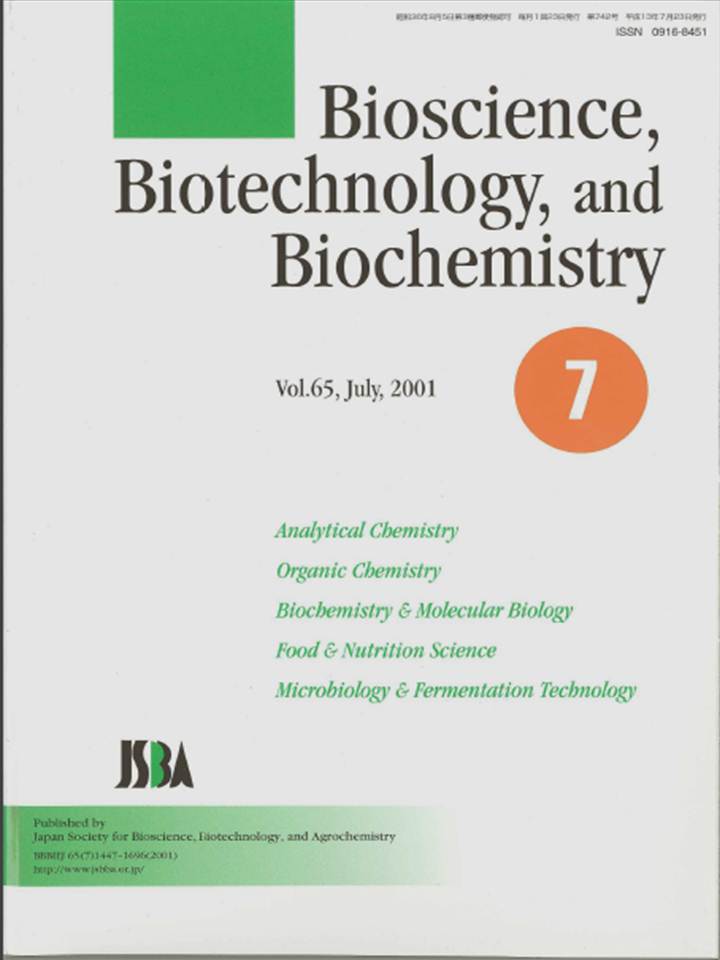Volume 65, Issue 7
Displaying 1-38 of 38 articles from this issue
- |<
- <
- 1
- >
- >|
Review
-
2001 Volume 65 Issue 7 Pages 1447-1457
Published: 2001
Released on J-STAGE: July 31, 2002
Download PDF (1800K)
Organic Chemistry
-
2001 Volume 65 Issue 7 Pages 1482-1488
Published: 2001
Released on J-STAGE: July 31, 2002
Download PDF (668K) -
Insecticidal and Neural Activities of Candidate Photoaffinity Probes for Neonicotinoid Binding Sites2001 Volume 65 Issue 7 Pages 1534-1541
Published: 2001
Released on J-STAGE: July 31, 2002
Download PDF (793K) -
2001 Volume 65 Issue 7 Pages 1559-1567
Published: 2001
Released on J-STAGE: July 31, 2002
Download PDF (961K) -
2001 Volume 65 Issue 7 Pages 1669-1672
Published: 2001
Released on J-STAGE: July 31, 2002
Download PDF (385K)
Biochemistry & Molecular Biology
-
2001 Volume 65 Issue 7 Pages 1511-1518
Published: 2001
Released on J-STAGE: July 31, 2002
Download PDF (1375K) -
2001 Volume 65 Issue 7 Pages 1519-1527
Published: 2001
Released on J-STAGE: July 31, 2002
Download PDF (1525K) -
2001 Volume 65 Issue 7 Pages 1528-1533
Published: 2001
Released on J-STAGE: July 31, 2002
Download PDF (927K) -
2001 Volume 65 Issue 7 Pages 1542-1548
Published: 2001
Released on J-STAGE: July 31, 2002
Download PDF (1493K) -
2001 Volume 65 Issue 7 Pages 1568-1574
Published: 2001
Released on J-STAGE: July 31, 2002
Download PDF (1259K) -
2001 Volume 65 Issue 7 Pages 1575-1580
Published: 2001
Released on J-STAGE: July 31, 2002
Download PDF (865K) -
2001 Volume 65 Issue 7 Pages 1581-1588
Published: 2001
Released on J-STAGE: July 31, 2002
Download PDF (798K) -
2001 Volume 65 Issue 7 Pages 1589-1595
Published: 2001
Released on J-STAGE: July 31, 2002
Download PDF (878K) -
2001 Volume 65 Issue 7 Pages 1601-1609
Published: 2001
Released on J-STAGE: July 31, 2002
Download PDF (1606K) -
2001 Volume 65 Issue 7 Pages 1610-1616
Published: 2001
Released on J-STAGE: July 31, 2002
Download PDF (842K) -
2001 Volume 65 Issue 7 Pages 1617-1626
Published: 2001
Released on J-STAGE: July 31, 2002
Download PDF (1674K) -
2001 Volume 65 Issue 7 Pages 1636-1644
Published: 2001
Released on J-STAGE: July 31, 2002
Download PDF (889K) -
2001 Volume 65 Issue 7 Pages 1645-1647
Published: 2001
Released on J-STAGE: July 31, 2002
Download PDF (809K) -
2001 Volume 65 Issue 7 Pages 1663-1668
Published: 2001
Released on J-STAGE: July 31, 2002
Download PDF (1227K) -
2001 Volume 65 Issue 7 Pages 1680-1683
Published: 2001
Released on J-STAGE: July 31, 2002
Download PDF (623K) -
2001 Volume 65 Issue 7 Pages 1684-1687
Published: 2001
Released on J-STAGE: July 31, 2002
Download PDF (720K) -
2001 Volume 65 Issue 7 Pages 1688-1691
Published: 2001
Released on J-STAGE: July 31, 2002
Download PDF (392K) -
2001 Volume 65 Issue 7 Pages 1692-1696
Published: 2001
Released on J-STAGE: July 31, 2002
Download PDF (1193K)
Food & Nutrition Science
-
Effects of α-D-Glucosylglycerol on the in Vitro Digestion of Disaccharides by Rat Intestinal Enzymes2001 Volume 65 Issue 7 Pages 1458-1463
Published: 2001
Released on J-STAGE: July 31, 2002
Download PDF (589K) -
2001 Volume 65 Issue 7 Pages 1489-1494
Published: 2001
Released on J-STAGE: July 31, 2002
Download PDF (894K) -
2001 Volume 65 Issue 7 Pages 1648-1651
Published: 2001
Released on J-STAGE: July 31, 2002
Download PDF (348K) -
2001 Volume 65 Issue 7 Pages 1652-1655
Published: 2001
Released on J-STAGE: July 31, 2002
Download PDF (363K) -
2001 Volume 65 Issue 7 Pages 1656-1658
Published: 2001
Released on J-STAGE: July 31, 2002
Download PDF (248K) -
Anti-inflammatory and Anti-allergic Actions by Oral Administration of a Perilla Leaf Extract in Mice2001 Volume 65 Issue 7 Pages 1673-1675
Published: 2001
Released on J-STAGE: July 31, 2002
Download PDF (293K)
Microbiology & Fermentation Technology
-
2001 Volume 65 Issue 7 Pages 1464-1473
Published: 2001
Released on J-STAGE: July 31, 2002
Download PDF (1443K) -
2001 Volume 65 Issue 7 Pages 1474-1481
Published: 2001
Released on J-STAGE: July 31, 2002
Download PDF (1072K) -
2001 Volume 65 Issue 7 Pages 1495-1503
Published: 2001
Released on J-STAGE: July 31, 2002
Download PDF (1667K) -
2001 Volume 65 Issue 7 Pages 1504-1510
Published: 2001
Released on J-STAGE: July 31, 2002
Download PDF (1406K) -
2001 Volume 65 Issue 7 Pages 1549-1558
Published: 2001
Released on J-STAGE: July 31, 2002
Download PDF (1026K) -
2001 Volume 65 Issue 7 Pages 1596-1600
Published: 2001
Released on J-STAGE: July 31, 2002
Download PDF (869K) -
2001 Volume 65 Issue 7 Pages 1627-1635
Published: 2001
Released on J-STAGE: July 31, 2002
Download PDF (1466K) -
2001 Volume 65 Issue 7 Pages 1659-1662
Published: 2001
Released on J-STAGE: July 31, 2002
Download PDF (546K) -
2001 Volume 65 Issue 7 Pages 1676-1679
Published: 2001
Released on J-STAGE: July 31, 2002
Download PDF (426K)
- |<
- <
- 1
- >
- >|
